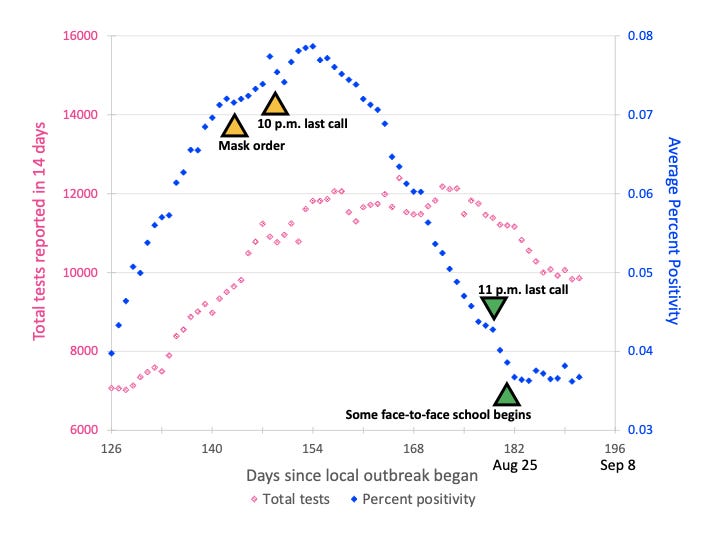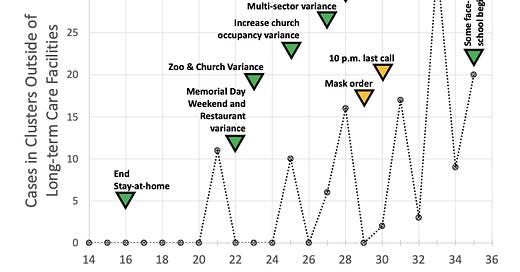COVID-19 Forecast for El Paso County — Sept. 7
Plus, our resident microbiologist on the possibility of having a vaccine this fall
Good morning, and happy Monday. On this pre-pandemic date last year, the Colorado Springs Fine Arts Center at Colorado College was hosting its annual Gala. (The FAC is currently closed.)
Today, Phoebe Lostroh returns to give her weekly COVID-19 forecast for El Paso County, and she also explains concerns over reports that a COVID-19 vaccine will be ready this fall. Lostroh is a professor of molecular biology at Colorado College on scholarly leave who is serving as the program director in Genetic Mechanisms, Molecular and Cellular Biosciences at the National Science Foundation.
🔌LISTEN: One of our correspondents, Arielle Gordon ’21, talked to KUNC’s “Colorado Edition” last week about CC’s new plans for the fall semester. Listen here.
📰FOR MORE CC UPDATES: We have partnered with The Catalyst, the independent student newspaper at Colorado College, to bring you these reports. They publish a newsletter every first, second, and third Friday of a CC block, and you can subscribe here.
Phoebe’s Forecasts
NOTES: These forecasts represent her own opinion and not necessarily those of the National Science Foundation or Colorado College. She used the public El Paso County dashboard for all data. Lostroh prepared these forecasts on Sept. 4.
⚖️ How her predictions last week shaped up: Sept. 5 is the last day of Morbidity and Mortality Weekly Report week 36 in the national public health calendar. It is the 26th week since the first case was detected in El Paso County. Since March 13, 157 El Paso County residents have died of COVID-19. Lostroh predicted between 6,032 and 6,312 cumulative cases reported as of Sept. 3, and there were actually 6,205.
“Unfortunately, the rate of new cases has not continued to decrease,” Lostroh says. Instead, El Paso County has had about the same number of cases reported in the last seven days (237) as the seven days before that (234).
Lostroh thinks El Paso County will probably see a total number of cases somewhere between the linear curve-fit and the exponential curve-fit this coming week because the percent positivity for nose-swab testing is holding steady at about 3.6%, and El Paso County has not seen a decline in cases in the last seven days. That would mean between 6,451 and 6,478 cumulative reported cases as of Sept. 10. Labor Day may interrupt testing or reporting, which could make the data look “a bit odd” next week, Lostroh says.
Predicted cumulative reported cases in El Paso County

🗝️ Key points: Some public health officials expect Labor Day to cause an increase in viral spread if people relax their physical distancing and hygiene practices because of the holiday. If that increase occurs, El Paso County could start seeing a turn toward the “Worst Case” scenario two to three weeks after Labor Day.
Reported cases in clusters connected to schools and businesses

🗝️ Key points: El Paso County defines an outbreak as “two or more confirmed cases within 14 days at the same facility.” Although the number of outbreaks at long-term care facilities has not increased, the frequency and number of cases associated with outbreaks at schools and businesses has increased.
14-day rolling average of daily new cases per 100,000 people in El Paso County

🗝️ Key points: The Harvard University Global Health Institute suggested the thresholds Lostroh uses in this forecast. El Paso County was in the orange zone from July 21 to Aug. 7 but has been in the safer yellow zone for about two weeks. Lostroh predicts El Paso County will stay in the yellow zone for two more weeks, meaning it’s safe for grades K-8 to meet in person if pandemic-resilient buildings, classrooms, and practices are in place.
Total nose-swab tests reported and rolling percent positivity

🗝️ Key points: The total number of tests reported in 14 days is plotted in pink using the left-hand axis while the percent positivity in those 14 days is plotted on the right-hand axis in blue. El Paso County has been beneath the important 5% positivity threshold for around 18 days but has hovered around 3.6% for the past 10 days, instead of decreasing.
Q-and-A with Lostroh: Our resident microbiologist on college students’ traveling home
This interview has been edited for length and clarity.
CC COVID-19 Reporting Project: Dr. Anthony Fauci recently warned that sending college students home could cause an increase in COVID-19 spread, yet Colorado College is asking most students to leave campus by Sept. 20. To what extent is this safe?
Lostroh: We did test everybody on arrival, and they have been doing random testing, so I think probably they’ve caught most of the cases that there are. I don’t think we’re going to see a whole bunch of infections in other communities — there’s always one or two that might get through, but I think the thought is things have been done as safely as they can be. I know that during any infectious disease outbreak scenario that we practice, it’s always a big question if there’s an infectious outbreak: do you send people home? Because if you’re going to send them home, you need to send them home before you think they’re infected. And so this is the time probably when it’s safest for people to go in case it should happen to get more spread through the population. So, you have to make these decisions before it gets really bad and then everybody’s mad because it doesn’t seem like things are that bad and yet they could get bad. It’s a tricky, tricky decision to have to make.
CCRP: What should we know about reports that a COVID-19 vaccine will be ready this fall?
Lostroh: I’m concerned about a vaccine that comes out and that bypasses the phase 3 safety and efficacy trials. I think rolling out a vaccine that turns out to have very low efficacy, or that has side effects we couldn’t anticipate because of testing only a small number of people, could be very dangerous not only for COVID-19 vaccination, but for all vaccination. Because we live in a crazy world right now where there are people actively arguing that vaccines are unsafe and using unscientific data and logical-sounding arguments that are not based on facts, to make those arguments about vaccines like the HPV vaccine against cervical cancer, and the measles vaccine. I think the risk of rolling out a vaccine that doesn’t work is that the vaccine is so in the public eye, right, like there’s going to be gazillions of stories about it. I think the risk of screwing up public goodwill toward vaccines in general is very high. Now that said, we need a COVID vaccine. There’s no doubt about that. The normal timeline was already quite accelerated, so I know for the vaccine trial that we could volunteer for here in Colorado Springs, they were planning to collect data for a year and then analyze the data, and they expected to maybe be able to roll it out in about two years, which is very very very very fast for any human vaccine. So, sometimes medications can be rolled out faster because you give medication to somebody who’s already sick, but you give a vaccine to healthy people. So there’s a higher safety barrier or a higher obligation to demonstrate safety in a larger number of diverse people before you start rolling out a vaccine to the general public. So I don’t know. October seems extremely fast to me. The other ones that are on that schedule are in China and Russia, and they have very different ways of regulating human subjects’ research than we do.
CCRP: The Pennsylvania State University football team doctor reported that 13–15% of Big Ten conference athletes who had COVID-19 now show signs of myocarditis. What does this mean about the long-term effects of the coronavirus?
Lostroh: That is a very concerning finding. [Myocarditis is] inflammation of the heart, or the tissue around the heart, and it can cause damage to the heart cells, and it can actually cause some of the cardiac cells, which have to beat, to die. And if they die, they don’t get replaced by normal heart cells. They get replaced by a different kind of cell type that doesn’t beat as efficiently. So it’s unlikely that all of those people will have permanent heart damage, but it is possible if you’ve had myocarditis that you will have lifelong heart damage, and I think it’s also concerning because these are top athletes who have very healthy hearts to start with. I think people have sort of been hoping, like, well if you’re really healthy to start with, maybe you won’t get severe COVID complications. And obviously these are top-line athletes, and yet they’ve got very serious complications.
About the CC COVID-19 Reporting Project
The CC COVID-19 Reporting Project is created by Colorado College student journalists Miriam Brown, Arielle Gordon, and Isabel Hicks, in partnership with The Catalyst, Colorado College’s student newspaper. Work by Phoebe Lostroh, Associate Professor of Molecular Biology at CC and National Science Foundation Program Director in Genetic Mechanisms, Molecular and Cellular Biosciences, will appear from time to time, as will infographics by Colorado College students Rana Abdu, Aleesa Chua, Sara Dixon, Jia Mei, and Lindsey Smith.
The project seeks to provide frequent updates about CC and other higher education institutions during the pandemic by providing original reporting, analysis, interviews with campus leaders, and context about what state and national headlines mean for the CC community.
📬 Enter your email address to subscribe and get the newsletter in your inbox each time it comes out. You can reach us with questions, feedback, or news tips by emailing ccreportingproject@gmail.com.


